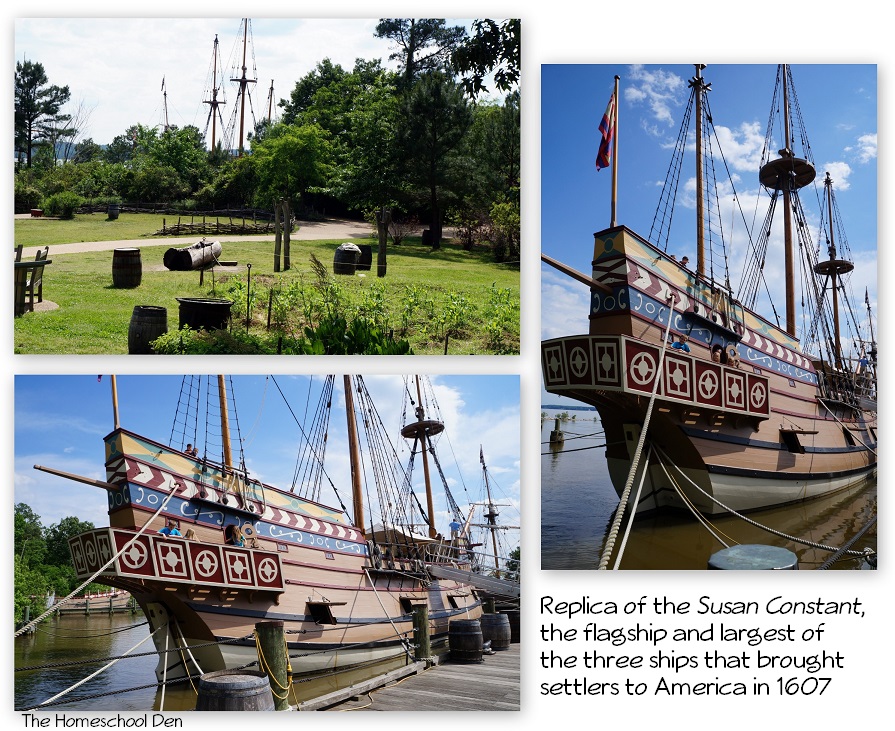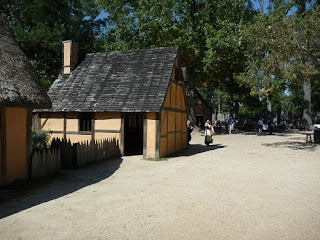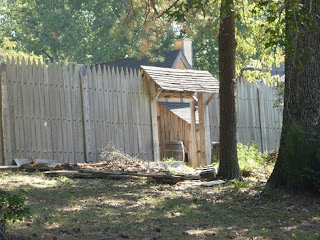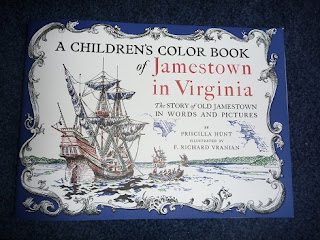Jamestown Settlement — What We Learned This Week
We have learned a lot about the history of Jamestown settlement this week:
 |
| Three hundred years ago,the English wanted to create a settlement in the Americas. They knew about all the gold and silver that the Spanish had been bringing back from the New World and were determined to gather some of these riches themselves. They financed a trip with three ships to sail to the New World, to Virginia. |
 |
| More than 100 men and boys crossed the Atlantic Ocean. Many of these men were quite wealthy and hoped to amass a great fortune in gold. |
 |
| The settlers had to bring all of their supplies — everything they would need to survive in the ‘untamed wilderness’ called Virginia. These supplies were brought over in the hold of the three small ships. |
  |
| Their journey took about five months. |
 |
| At first the settlers slept on the ships or in tents. Soon they set about building homes to live in, a church, armory and other structures. But the building process was slow as the wealthy men did not help as much as they should have. |
 |
| We got to see the inside of many of the buildings including the church, the armory, the warehouse, blacksmith’s shop and more. |
The colonists faced a lot of hardship. They faced starvation and illness. Many colonists died. John Smith faced his own trials as he was captured by the Powhatan Indians(but was saved by the Indian chief’s daughter, Pocahontas). Upon his release, relationships with the Indians improved and the Indians even brought food in the winter that saved the starving colonists.
 |
| The kids saw how hard everyone had to work. In the end, Jamestown became prosperous not from gold (they didn’t find any), but from growing tobacco. |
 |
| The kids tried on the armor, which was very, very heavy! |
If you are looking for a good book about the history of Jamestown settlement, I found this book just fabulous for LD (and for the early elementary grades). It is full of rich history details (for example, when John Smith became President at Jamestown, he made the colonists work hard. If a colonist cursed, he had cold water poured down his sleeve!)
 |
| This is a coloring book, though we’re not using it in that way. It provided rich pictures for LD to look at as I read the history of Jamestown. It is called A Children’s Color Book of Jamestown in Virginia by Priscilla Hunt. |
Finally, we went through the reconstructed Powhatan Indian village. The recreated village was based on archaeological evidence from an excavated Paspahegh Indian site. I didn’t get any pictures, but the kids were able to try making rope for a fishing net, grind corn and play a traditional game. We wandered through all of the long houses. They were made by bending saplings and placing woven mats or bark over top of the saplings.
The kids really liked exploring all of the long houses which were full of fishing traps and nets, skins from all kinds of animals, bowls, tools, weapons, bags and things like that.
Below is a picture of Chief Powhatan in a longhouse. It is from a 1612 map of Virginia by John Smith:
Picture courtesy of Wikipedia
Large version of this map can be viewed at Virtual Jamestown
If you have the opportunity, Jamestown Festival Park is definitely a fabulous place to take the kids. It was educational; there was tons to see and do!
I’ll share a few other children’s books in another post that have really made our studies of Jamestown come alive for the kids.
Here are some of the books we read this week. They really helped bring the rich history of Jamestown settlement alive for the kids.
Molly Bannaky by Alice McGill — This book was BEAUTIFUL! The illustrations were gorgeous and the story was compelling. This is the story of Molly Bannaky, who was brought to the New World as an indentured servant. She wound up buying a slave, falling in love with and marrying him. Her grandson, Benjamin Banneker became a well known scientist.
Sam Collier and the Founding of Jamestown by Candice Ransom — This story told about the founding of Jamestown from the perspective of one of the boys who came to Jamestown.
The True Story of Pocahontas by Lucille Recht Penner — This added some rich detail about Pocahontas since the other books only briefly mentioned her role in protecting John Smith when he was captured by her father, the Chief of the Powhatan Indians.
Historic Communities: Colonial Life by Bobbie Kalman — includes actual photographs which help bring the era to life.
A Children’s Color Book of Jamestown in Virginia by Priscilla Hunt — This book was 46 pages with a paragraph on one page and a drawing to color on the adjoining page. The history was really rich in detail and I would HIGHLY recommend this for anyone wanting to learn about the history of Jamestown settlement (for early elementary ages).
I would highly recommend any and all of these books!
Disclosure: Please note that some of the links in this post are affiliate links, and at no additional cost to you, I will earn a commission if you decide to make a purchase.



























































Great and very interesting posting. Thank you very much for sharing your learning and trip.
Great and very interesting posting. Thank you very much for sharing your learning and trip.